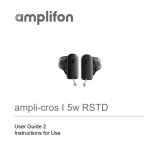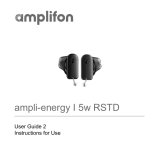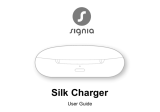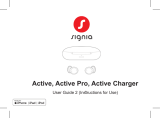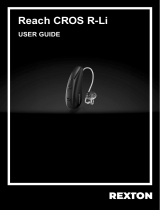Page is loading ...

ampli-charge R 3
User Guide 2
Inructions for Use

2
CAUTION
It is important to read this user guide thoroughly and
completely.
It is also important to read and follow the user guide 2
(inructions for use) and user guide 1 (safety manual)
for the hearing aid you use with this accessory. Follow
the safety information to avoid damage or injury.

3
Content
Before you art 5
Components 6
Connecting the USB power cable 7
How you can use the charger 8
Charging 10
Turning the charger on or o 11
Charging the charger 11
Charging hearing aids 15
Charging tips 17
Further information 22
Maintenance and care 22
Troubleshooting 23
Important safety information 24
General warnings 24
Personal safety 27
Product safety 29

5
Before you art
This device is intended to charge our specic hearing aids
with built-in power cells (lithium-ion rechargeable batteries).
Your Hearing Care Professional will advise you on the
compatible models.
The charger is only intended for indoor use. Observe
and follow the operating conditions in section
"Operating, transport, and orage conditions".
The charger is not intended as a means of orage for
transportation of hearing aids.

6
Components
➏
➎
➊Removable silicone lining
➋Charging slots
➌Hearing aid LEDs
➍Charger LED
➎Push button
➏Power port
➐USB power cable
➑Power adapter

7
Charger data
Under the removable silicone lining in the lid of
the charger is a label with symbols, serial number,
CE mark and legal manufacturer of the charger. Lift
the lining from the lid close to the hinge area with your
ngernail and pull it o carefully. To reinsert, press
around the edges.
Connecting the USB power cable
XConnect your USB power cable to the provided power
adapter.

8
How you can use the charger
Charging via electrical outlet
When the charger is plugged in, it
charges the hearing aids (if they are
placed in the charger) and it charges
the integrated battery at the same time.
As long as the charger is being charged
by an external power source, charger
LED shows the charging atus of the integrated battery and
the LEDs for the hearing aids show the atus of the hearing
aids.
Mobile charging
When you are mobile with no electrical
outlet available, you can ill charge
your hearing aids. Energy is fed from
the charger's integrated battery into your
hearing aids.The charger mu be turned on
to do so.
The charging atus of charger and hearing aids is shown by
pushing the button or opening the lid.

9
Safekeeping
When charging of hearing aids is completed,
safely ore your hearing aids inside the
charger with lid closed.
In case you want to ore the hearing
aids for a longer time, you can turn o the
charger. The charger can only be turned o
when there is no power source connected into the charger.

10
Charging
NOTICE
Please make sure that the power adapter is easily
accessible to remove it from power supply if
necessary.
zConnect the charger to the power supply.
zCharging of the internal battery now arts. This is
indicated by the pulsing green LED light of the charger.
zWhen hearing aids are inserted, they art charging as
well. This is indicated by the pulsing green LED light of
the hearing aids LED.
zThe charging atus is shown permanently.

11
Turning the charger on or off
When the charger is connected to an electrical outlet, it is
automatically turned on and cannot be turned o.
During mobile charging, press and hold the button for
5 seconds to turn the charger on or o.
zWhen the charger turns on, the atus of the hearing
aids and the atus of the charger's internal battery are
displayed for 7 seconds.
zWhen the charger turns o, the front LED lights up green
and fades out over a period of approximately 7 seconds.
Shut down is complete after approximately 7 seconds.
Charging the charger
The charger LED indicates the
charging atus of the charger and its
internal battery.
While the internal battery is being
charged, the charging atus is
indicated as follows:

12
LED when charger is charging
Pulsing green
Internal battery is being charged.
Solid green
Charger is fully charged.
Blinking red
Charger error. Please refer to section "Troubleshooting".
For an overview of the hearing aids' charging atus, refer to
the section "Charging hearing aids".

13
Checking the battery capacity of your charger
To check whether the charger's internal battery has enough
capacity to fully charge your hearing aids when you are
mobile:
XDisconnect the charger from the electrical outlet.
XBriefly press the
push button.
XThe charger LED indicates
the atus of the charger's
internal battery for
7 seconds.

14
LED when you are mobile
Solid green
The internal battery has enough capacity to fully charge a
pair of hearing aids.
Solid orange
The internal battery does not have enough capacity to fully
charge a pair of hearing aids.
Blinking orange
The internal charger battery is empty. Charging of
hearing aids is not possible.
If the atus LED does not light up when you press the
button, check the following:
zThe charger is o. Press and hold the button for
5 seconds to turn on the charger.
zThe charger's internal battery is too low to display the
atus. Connect the charger to an electrical outlet, wait
several minutes and try again.

15
Charging hearing aids
XAs illurated, place the right
hearing aid in the charging
slot marked with an "R", and
the left hearing aid in the
charging slot marked with
an "L".
XMake sure the bottom of the hearing
aids are placed well into the charging
slots.
XCorrect placement will be indicated by
the LED.
XClose the charger's lid.
XThe hearing aids are automatically
turned o and art charging. The
charging atus is shown for 7 seconds.
XYou can charge both hearing aids at the
same time.

16
If the atus LEDs do not light up when you insert the
hearing aids, check the following:
zThe hearing aids are not correctly placed. Push them
slightly into their charging slots or close the charger's lid.
zThe charger is turned o. Press and hold the button for
5 seconds to turn on the charger or connect the charger
to an electrical outlet.
zThe charger's internal battery is too low for mobile
charging. Connect the charger to an electrical outlet.
Charging atus of hearing aids
The two LEDs next to the hearing
aids indicate the charging atus of
the hearing aids.
Note that the atus is only displayed
immediately after putting the hearing
aids in the charger, when you briefly
press the button or when you open the lid.
When the charger is o, no atus is displayed at all.

17
Hearing aid LED
Pulsing green
Hearing aid is being charged.
Solid green
Hearing aid is fully charged.
LED is o
No hearing aid is in the charger, a hearing aid is not placed
correctly, or the charger is discharged.
Blinking red
Hearing aid error. Please refer to section
"Troubleshooting".
Charging tips
You may have some queions on how to be charge your
hearing aids. Read the queions and answers below. If you
have more queions, your Hearing Care Professional will
help you.

18
"
How often do I need to charge the hearing aids?
We recommend charging the hearing aids daily, even if the
power cell is not empty. Charge them overnight so you can
be sure to art your day with fully-charged hearing aids.
"How long does charging take?
A full charging cycle takes approximately 4 hours
(+/- 10 mins).
After 30 minutes, it is possible to use your hearing aids for
up to 6 hours.
Charging times may vary due to the use of the hearing aids
and the age of the power cell.
"
Can I leave the hearing aids in the charger?
Even when fully charged, you can leave the hearing aids
in the charger with the lid closed. They automatically op
charging when they are fully charged.

19
"
What happens if I forgot to charge?
Your hearing aids will automatically switch-o when the
power cell is empty. Charge the hearing aids as soon as
possible.
Hearing aids which have not been charged for over
6 months may be damaged due to an unrecoverable deep-
discharge of the power cell. Deep-discharged power cells
cannot be charged anymore and have to be replaced.
"What if I intend not to use the hearing aids for
several days or longer?
zShort-term orage (up to several days): Turn o your
hearing aids via the push button or place them in the
powered charger with the lid closed.
The charger mu be connected to the power supply. If
the charger is not connected to power supply and you
place your hearing aids in the charger, the hearing aids
are not turned o.
Note that when you turn o the hearing aids via a remote
control or smartphone app, the hearing aids are not
turned o completely. They are in andby-mode and ill
draw some power.

20
zLong-term orage (weeks, months, ...): Fir, fully charge
your hearing aids. Turn them o via the push button
before oring them. We recommend to use drying
products while oring the hearing aids.
At 6 month intervals you will have to charge the hearing
aids to avoid an unrecoverable deep-discharge of the
power cell. Deep-discharged power cells cannot be
charged anymore and they have to be replaced. We
recommend recharging more frequently than 6 months
intervals.
Observe the orage conditions in hearing aids' user
guide.
Ask your Hearing Care Professional for recommended
drying products.
"
What should I pay attention to when charging?
The hearing aids and charger mu be clean and
dry. Observe the operation conditions in section
"Operating, transport, and orage conditions". Avoid
charging at high ambient temperatures, as this can shorten
the life span and capacity of the power cell.
/





